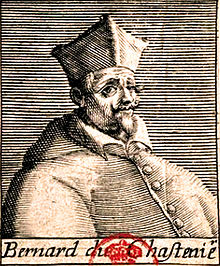Bernard de Castanet
This article has multiple issues. Please help improve it or discuss these issues on the talk page. (Learn how and when to remove these messages)
|
Bernard de Castanet | |
|---|---|
 Cardinal Bernard de Castanet | |
| Orders | |
| Created cardinal | 17 December 1316 |
| Personal details | |
| Born | c. 1240 |
| Died | 14 August 1317 Avignon |
| Nationality | French |
| Denomination | Roman Catholic |
Bernard de Castanet (c. 1240 – 14 August 1317) was the bishop and cardinal of the Roman Catholic Church.
Castenet was not a Dominican, though he had an excellent relationship with the order of the Preachers. He was Inquisitor of Languedoc and Vice-Inquisitor of France.[1]
Early life
Castanet was born in Montpellier and obtained a law degree from the University of Montpellier. He conducted diplomacy for the Church in Italy and Germany.[2]
Bishop of Albi
Castanet was appointed the Bishop of Albi (1276 to 1308). In this post, Castenet engaged in a power struggle with the local landowners. He used accusations of heresy and the inquisition to control and punish those who opposed his right to arrest any citizen in the diocese and other political power prerogatives he held.
In 1287 Castanet ordered the start of construction on a new fortress-like cathedral at Albi.[1]
In 1307, he was accused of murder, pastoral neglect, simony, cruelty in the exercise of justice. No sentence was issued, but he was transferred to become the Bishop of Le Puy-en-Velay.
Later life
Pope John XXII, an old friend, made Castanet a cardinal on 17 December 1316 and he joined the papal curia. In Avignon, he wrote the initial indictment of Bernard Délicieux.[3]
Sources
- Lambert, Malcolm D. The Cathars. p. 228
- Bony, Jean. French Gothic Architecture. p. 449-451.
- Jean-Louis Biget, Un procès d’Inquisition à Albi en 1300, dans Le crédo, la morale et l’Inquisition. Cahiers de Fanjeaux 6, 1971, p. 273-341.
- Jean-Louis Biget, La restitution des dîmes par les laïcs dans le diocèse d'Albi à la fin du XIIIe siècle, dans Les évêques, les clercs et le roi (1250-1300). Cahiers de Fanjeaux 7, 1972, p. 211-283.
- Hiromi Haruna-Czaplicki, Le décor des manuscrits de Bernard de Castanet et l'enluminure toulousaine vers 1300, Mémoires de la Société archéologique du Midi de la France, t. LXVIII, 2008, p. 227-281, available online on the website of french "Sociétés savantes".
- Julien Théry (2000), "Les Albigeois et la procédure inquisitoire. Le procès pontifical contre Bernard de Castanet, évêque d'Albi et inquisiteur (1307-1308)", Heresis, 33, 2000, p. 7-48, available online.
- Julien Théry (2003), Fama, enormia. L'enquête sur les crimes de l'évêque d'Albi Bernard de Castanet (1307-1308). Gouvernement et contestation au temps de la théocratie pontificale et de l'hérésie des bons hommes, thèse de doctorat en Histoire, Faculté de Géographie, Histoire, Histoire de l'Art et Tourisme, Université Lumière Lyon 2, 2003, 3 vol. (résumé).
- Julien Théry (2001), "Une politique de la terreur : l'évêque d'Albi Bernard de Castanet (v. 1240-1317) et l'Inquisition", dans Les inquisiteurs. Portraits de défenseurs de la foi en Languedoc (XIIIe-XIVe s.), dir. L. Albaret, Toulouse : Privat, 2001, p. 71-87, available online.
- Julien Théry (2003),"Fama. L'opinion publique comme preuve. Aperçu sur la révolution médiévale de l'inquisitoire", dans La preuve en justice de l'Antiquité à nos jours, dir. Bruno Lemesle, Presses universitaires de Rennes, 2003, p. 119-147, available online.
- Patrick Gilli and Julien Théry, La vague guelfe dans l'Italie des communes urbaines après la bataille de Bénévent : une mission pontificale à Crémone et à Plaisance (1266-1267), dans Le gouvernement pontifical et l'Italie des villes au temps de la théocratie (fin-XIIe-mi-XIVe s.), Montpellier, Presses universitaires de la Méditerranée, 2010, p. 113-200.
- Julien Théry (2012), "Cum verbis blandis et sepe nephandis. Une mission pontificale en Lombardie après la bataille de Bénévent (1266-1267)", dans Legati e delegati papali. Profili, ambiti d’azione e tipologie di intervento nei secoli XII-XIII, dir. Maria Pia Alberzoni, Claudia Zey, Milan, Vita & pensiero, 2012, p. 195-218, available online.
- Julien Théry-Astruc (2014), "Luxure cléricale, gouvernement de l'Église et royauté capétienne au temps de la 'Bible de saint Louis'", Revue Mabillon, 25, p. 165-194, at p. 174-177, online.
References
- ^ a b Kurmann, Peter (2010). "Late Gothic Architecture in France and the Netherlands". In Toman, Rolf (ed.). Gothic Architecture, Sculpture, Painting. Potsdam: H.F. Ullmann. pp. 162–163. ISBN 978-3-8331-1038-2.
- ^ O'Shea, Stephen (2011). The Friar Of Carcassonne. Douglas & McIntyre. p. 74. ISBN 978-1-55365-551-0.
- ^ O'Shea, Stephen (2011). The Friar Of Carcassonne. Douglas & McIntyre. pp. xv. ISBN 978-1-55365-551-0.
